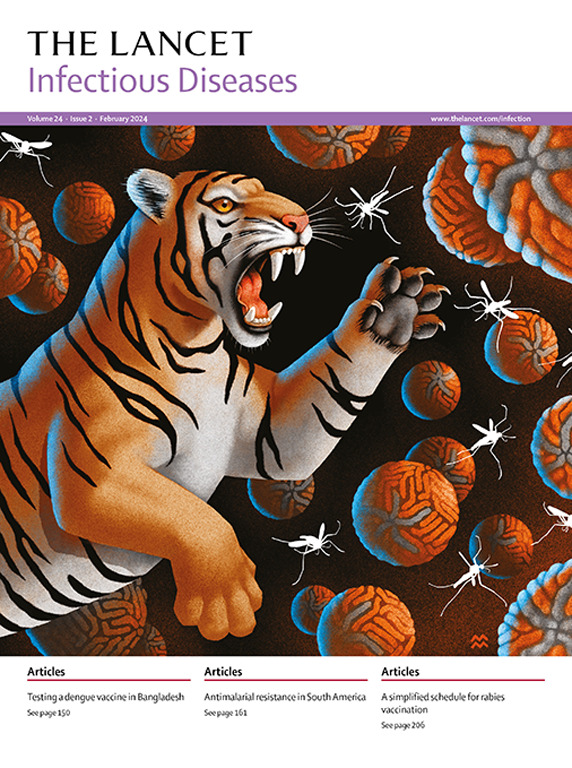二价(Asp614Gly 和 omicron BA.4/5 变异株)自扩增 mRNA SARS-CoV-2 强化疫苗与 BNT162b2 omicron BA.4/5 mRNA 疫苗的免疫原性对比:随机 3 期试验
IF 31
1区 医学
Q1 INFECTIOUS DISEASES
引用次数: 0
摘要
背景我们以前的研究表明,与传统的 mRNA 或腺病毒载体疫苗相比,自扩增 mRNA COVID-19 疫苗 ARCT-154 具有更好的免疫原性和抗体持久性。在本研究中,我们将 ARCT-2301 这种二价自扩增 mRNA 疫苗(Asp614Gly 和 omicron BA.4/5 变异株)与二价 Comirnaty omicron BA.4-5 疫苗进行了比较,以确定在二价制剂中针对不同的 SARS-CoV-2 变异株是否会持续产生更好的反应。符合条件的参与者均为健康的日本成年人,年龄至少在 18 岁以上,曾接种过 3 至 5 剂 mRNA COVID-19 疫苗(Comirnaty 或 Spikevax [Moderna])的全套免疫系列,最后一剂疫苗至少在本试验筛选前 3 个月接种过。参与者通过交互式计算机生成的随机分配(1:1)被随机分配到ARCT-2301或Comirnaty BA.4-5 mRNA疫苗,每组4人。随机分配按性别(男性 vs 女性)、年龄组(65 岁 vs ≥65 岁)、上次接种的疫苗类型(二价奥美康 BA.1 vs 二价奥美康 BA.4/5)和上次接种 COVID-19 疫苗的时间(5 个月 vs ≥5 个月)进行分层。ARCT-2301 采用小瓶包装,内含 100 μg 冻干 mRNA、50 μg mRNA(分别编码祖先 Asp614Gly SARS-CoV-2 株和 omicron BA.4/5 变异株的全长尖峰蛋白)。使用前,每个小瓶立即用 10 mL 生理盐水重新配制。对比组原始 omicron BA.4/5 mRNA 疫苗(Comirnaty BA.4-5)以即用型小瓶供应,每瓶含 0-3 mL 体积的 30 μg mRNA。两种疫苗均采用非优势臂三角肌肌肉注射。研究的主要结果是证明 ARCT-2301 与 Comirnaty BA.4-5 的免疫原性在第 29 天的中和抗体几何平均滴度(GMT)和血清反应率方面对 omicron BA.4/5 无劣效。主要分析按方案进行。研究结果在2023年9月29日至11月18日期间,我们招募了930名参与者(451名男性和479名女性)接受ARCT-2301(465人)或Comirnaty BA.4-5(465人)的加强剂量。根据 GMT 比值(1-49,95% CI 1-26-1-76)和血清反应率差异(7-2%,95% CI 0-6-13-7),ARCT-2301 在第 29 天引起的针对 omicron BA.4/5 的抗体反应不劣于 Comirnaty BA.4-5。此外,两组间抗体反应的差异显示,ARCT-2301 在两种标准下均优于武汉-Hu-1,GMT 比值为 1-45(95% CI 1-28-1-63),血清反应率差异为 12-5%(95% CI 5-9-19-0);优于 omicron XBB.1.5,GMT 比值为 1-63(95% CI 1-36-1-94),血清反应率差异为 16-7%(95% CI 10-1-23-2)。两种疫苗的耐受性良好,主要存在轻微、短暂的诱发性不良反应,未出现因果关系相关的严重不良反应。与Comirnaty BA.4-5相比,用ARCT-2301增强mRNA免疫成人对武汉-Hu-1和omicron BA.4/5变体COVID-19的免疫原性更强,对omicron XBB.1.5的反应更高。两种疫苗的耐受性相似。自扩增 mRNA 疫苗能以较低的 mRNA 剂量诱导强大的免疫反应,从而实现更广泛、更公平的分配,为大流行病的防备和应对做出重大贡献。本文章由计算机程序翻译,如有差异,请以英文原文为准。
Immunogenicity of a booster dose of a bivalent (Asp614Gly and omicron BA.4/5 variant) self-amplifying mRNA SARS-CoV-2 booster vaccine versus the BNT162b2 omicron BA.4/5 mRNA vaccine: a randomised phase 3 trial
Background
We previously showed that ARCT-154, a self-amplifying mRNA COVID-19 vaccine, had improved immunogenicity and antibody persistence compared with conventional mRNA or adenovirus vector vaccines. In this study, we compared ARCT-2301, a bivalent self-amplifying mRNA vaccine (Asp614Gly and omicron BA.4/5 variant), with the bivalent Comirnaty omicron BA.4-5 vaccine, to determine whether this improved response persisted in bivalent formulations against different SARS-CoV-2 variants.Methods
This randomised, multicentre, phase 3, observer-masked, active-controlled comparative study was done at nine hospitals in Japan. Eligible participants were healthy Japanese adults, aged at least 18 years, who had previously received a full immunisation series of three to five doses of mRNA COVID-19 vaccines (Comirnaty or Spikevax [Moderna]), with the last dose received at least 3 months before screening for this trial. Participants were randomly assigned (1:1) to either ARCT-2301 or Comirnaty BA.4-5 mRNA vaccine using interactive computer-generated randomisation with a block size of four. Randomisation was stratified by gender (men vs women), age group (<65 years vs ≥65 years), type of vaccine used for last vaccination (bivalent omicron BA.1 vs bivalent omicron BA.4/5), and time since last COVID-19 vaccination (<5 months vs ≥5 months). ARCT-2301 was supplied in vials containing 100 μg lyophilised mRNA, 50 μg mRNA each coding for the full-length spike proteins of the ancestral Asp614Gly SARS-CoV-2 strain and omicron BA.4/5 variant. Immediately before use, each vial was reconstituted with 10 mL saline. The comparator original omicron BA.4/5 mRNA vaccine (Comirnaty BA.4-5) was supplied in ready-to-use vials containing a single dose of 30 μg mRNA in 0·3 mL volume. Both vaccines were administered by intramuscular injection in the deltoid of the non-dominant arm. The primary outcome of the study was to show non-inferiority of immunogenicity of ARCT-2301 versus Comirnaty BA.4-5 at day 29 as neutralising antibody geometric mean titres (GMT) and seroresponse rates against omicron BA.4/5. Primary analyses were done in a per-protocol manner. The trial is registered with the Japan Registry for Clinical Trials, jRCT2031230340.Findings
Between Sept 29 and Nov 18, 2023, we enrolled 930 participants (451 men and 479 women) to receive a booster dose of ARCT-2301 (n=465) or Comirnaty BA.4-5 (n=465). The primary immunogenicity outcome to show that the antibody response at day 29 against omicron BA.4/5 elicited by ARCT-2301 was non-inferior to that elicited with Comirnaty BA.4-5 was achieved, both by GMT ratio (1·49, 95% CI 1·26–1·76) and difference in seroresponse rate (7·2%, 95% CI 0·6–13·7). Furthermore, the differences in antibody response between the groups showed superiority for ARCT-2301 against Wuhan-Hu-1 using both criteria, with a GMT ratio of 1·45 (95% CI 1·28–1·63) and a difference in seroresponse rate of 12·5% (95% CI 5·9–19·0), and omicron XBB.1.5, with a GMT ratio of 1·63 (95% CI 1·36–1·94) and a seroresponse rate difference of 16·7% (95% CI 10·1–23·2). Both vaccines were well-tolerated with mainly mild, transient solicited adverse events and no causally related severe or serious adverse events.Interpretation
Boosting mRNA-immunised adults with ARCT-2301 induced superior immunogenicity compared with Comirnaty BA.4-5 against both Wuhan-Hu-1 and omicron BA.4/5 variant COVID-19, and elicited a higher response against omicron XBB.1.5. Both vaccines had similar tolerability profiles. Self-amplifying mRNA vaccines could provide a substantial contribution to pandemic preparedness and response, inducing robust immune responses with a lower dose of mRNA to allow wider and more equitable distribution.Funding
Japanese Ministry of Health, Labour, and Welfare and Meiji Seika Pharma.求助全文
通过发布文献求助,成功后即可免费获取论文全文。
去求助
来源期刊

Lancet Infectious Diseases
医学-传染病学
CiteScore
60.90
自引率
0.70%
发文量
1064
审稿时长
6-12 weeks
期刊介绍:
The Lancet Infectious Diseases was launched in August, 2001, and is a lively monthly journal of original research, review, opinion, and news covering international issues relevant to clinical infectious diseases specialists worldwide.The infectious diseases journal aims to be a world-leading publication, featuring original research that advocates change or sheds light on clinical practices related to infectious diseases. The journal prioritizes articles with the potential to impact clinical practice or influence perspectives. Content covers a wide range of topics, including anti-infective therapy and immunization, bacterial, viral, fungal, and parasitic infections, emerging infectious diseases, HIV/AIDS, malaria, tuberculosis, mycobacterial infections, infection control, infectious diseases epidemiology, neglected tropical diseases, and travel medicine. Informative reviews on any subject linked to infectious diseases and human health are also welcomed.
 求助内容:
求助内容: 应助结果提醒方式:
应助结果提醒方式:


